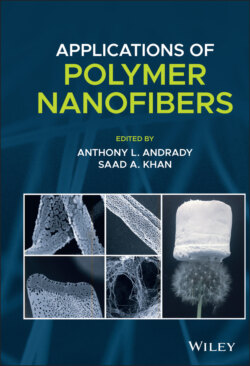Читать книгу Applications of Polymer Nanofibers - Группа авторов - Страница 23
1.5.1 Nonpolymer Electrospinning
ОглавлениеTraditionally, electrospinning has been limited to high molecular weight polymers. Generally, polymer networks are thought to provide molecular, entanglement, and elasticity to achieve uniform fibers (Shenoy et al. 2005; Yu et al. 2006). Polymer‐free electrospinning explores fabricating nanoscale fibers from small molecules and offers potential for new applications (Table 1.2).
Phospholipids and Gemini surfactants, amphiphilic molecules with molecular weights of ~700 and ~300 g/mol, respectively, for example, have been electrospun into uniform fibers (McKee et al. 2006; Cashion et al. 2010). Both amphiphilic molecules self‐assemble into spheres or worm‐like micelles in solution. The worm‐like micelles behave analogous to polymer chains and can entangle due to hydrogen bonding and other intermolecular interactions (McKee et al. 2006). In the case of Gemini surfactants, the transition from globular to branched micelle network resulted in an increase in viscoelasticity of the solution and electrospinning of continuous fibers (Cashion et al. 2010). The fibers are of interest for controlled release applications (Cashion et al. 2010; Hemp et al. 2014).
Table 1.2 Nonpolymer electrospinning systems.
| Material | Solvent | Concentration | Fiber diameter (μm) |
|---|---|---|---|
| Phospholipids (McKee et al. 2006) | CHCl3/DMF | 43 wt% | 2.8 |
| Gemini surfactants (Cashion et al. 2010) | Water/methanol | 28–30 wt% | 0.9–7 |
| 42–44 wt% | 4–5 | ||
| Phosphonium Gemini surfactants (Hemp et al. 2014) | Chloroform | 52 wt% | 0.7–1.3 |
| HPβCD (Celebioglu and Uyar 2012; Manasco et al. 2012) | Water, DMF, DMAc | 120–160% (w/v) | 0.7–1.4 |
| Water | 70 wt% | 1–1.2 | |
| HPγCD (Celebioglu and Uyar 2012; Manasco et al. 2012) | Water, DMF, DMAc | 125–160% (w/v) | 1.2–6.4 |
| MβCD (Celebioglu and Uyar 2012; Manasco et al. 2012) | Water, DMF, DMAc | 140–160% (w/v) | 0.1–1.2 |
| Water | 70 wt% | 0.4–0.5 | |
| Diphenylalanine (FF) (Singh et al. 2008) | HFIP | 13–17.5 wt% | 0.4–0.85 |
| Fmoc‐FG (Fmoc‐Phe‐Gly) (Nuansing et al. 2013) | HFIP | 18 wt% | 0.3 |
| FF‐Tetraphenylporphyrin (Nuansing et al. 2014) | HFIP | 9.1 wt% | <0.2–1.6 |
Cyclodextrin, a toroid‐shaped oligosaccharide (~1000 g/mol) has also been successfully electrospun into uniform fibers (Celebioglu and Uyar 2012; Manasco et al. 2012). For example, modified cyclodextrins such as hydroxypropyl‐β‐cyclodextrin and methyl‐β‐cyclodextrin have been used for electrospinning at high concentrations, e.g. 70 wt%. Fiber formation has been attributed due to hydrogen‐bonding‐induced aggregation behavior indicated by the increase in solution viscosity. Such fibers are promising for drug delivery applications (Celebioglu and Uyar 2011; Celebioglu et al. 2014; Vigh et al. 2013).
Other small molecules have also been successfully electrospun into fibers. These small molecules require high concentrations and a solvent that is highly volatile and electrophilic such as hexafluoro‐2‐propanol (HFIP) or trifluoroacetic acid (TFA) (Nuansing et al. 2013). Peptides such as diphenylalanine have been electrospun into 400–850 nm fibers due to π‐interaction of the phenyl groups entangling the molecules (Singh et al. 2008). Fmoc‐FG (Fmoc‐Phe‐Gly) is another peptide with aromatic groups that would allow for π‐stacking and hydrogen bonding to form continuous fibers. At 18 wt% Fmoc‐FG produced circular fibers, whereas at higher concentrations, it produced ribbons with a needle‐like topography (Nuansing et al. 2013). Tetraphenylporphyrin, a porphyrin derivate used in photovoltaic devices, has been electrospun at a concentration over 9 wt% to produce a beads‐on‐a‐string morphology. The entanglement of these molecules was enhanced by addition of diphenylalanine which increased π‐stacking due to the presence of phenyl groups (Nuansing et al. 2014).
Recently, colloid electrospinning has been explored as means to create nanofibers with unique properties. Suspensions containing colloids (inorganic or organic, i.e. polymeric) and a small amount (~few wt%) of a fiber‐forming polymer has been used as a template. Inorganic nanoparticles, e.g. metal, metalloid oxide, aluminosilicates, hydroxyapatite, and nonoxide ceramics, are the most common. Silica and polymer particle electrospinning dispersed in a solution of a second incompatible polymer has also been considered. As the jet thins, the particles are in close contact leading to high‐packing densities in the resulting fibers. Due to the timescale of particle arrangement (milliseconds), the resulting structure is less ordered than classical hexagonal packing observed in films (Crespy et al. 2012). Bead formation during electrospinning may lead to colloid aggregation. Adding salt to increase the net charge density can reduce bead formation. The resulting hierarchical structures are especially promising for superhydrophobic materials.
Similarly, cells such as bacteria, viruses, yeast, and mammalian cells have also been electrospun from suspension (Crespy et al. 2012; Zussman 2011; Canbolat et al. 2011, 2013). Mammalian cells dehydrate during fiber formation (Canbolat et al. 2011). Yeast and viruses are more robust and show some biological activity after electrospinning (Crespy et al. 2012; Canbolat et al. 2013). However, maintaining biological function after direct electrospinning remains challenging (Crespy et al. 2012).
